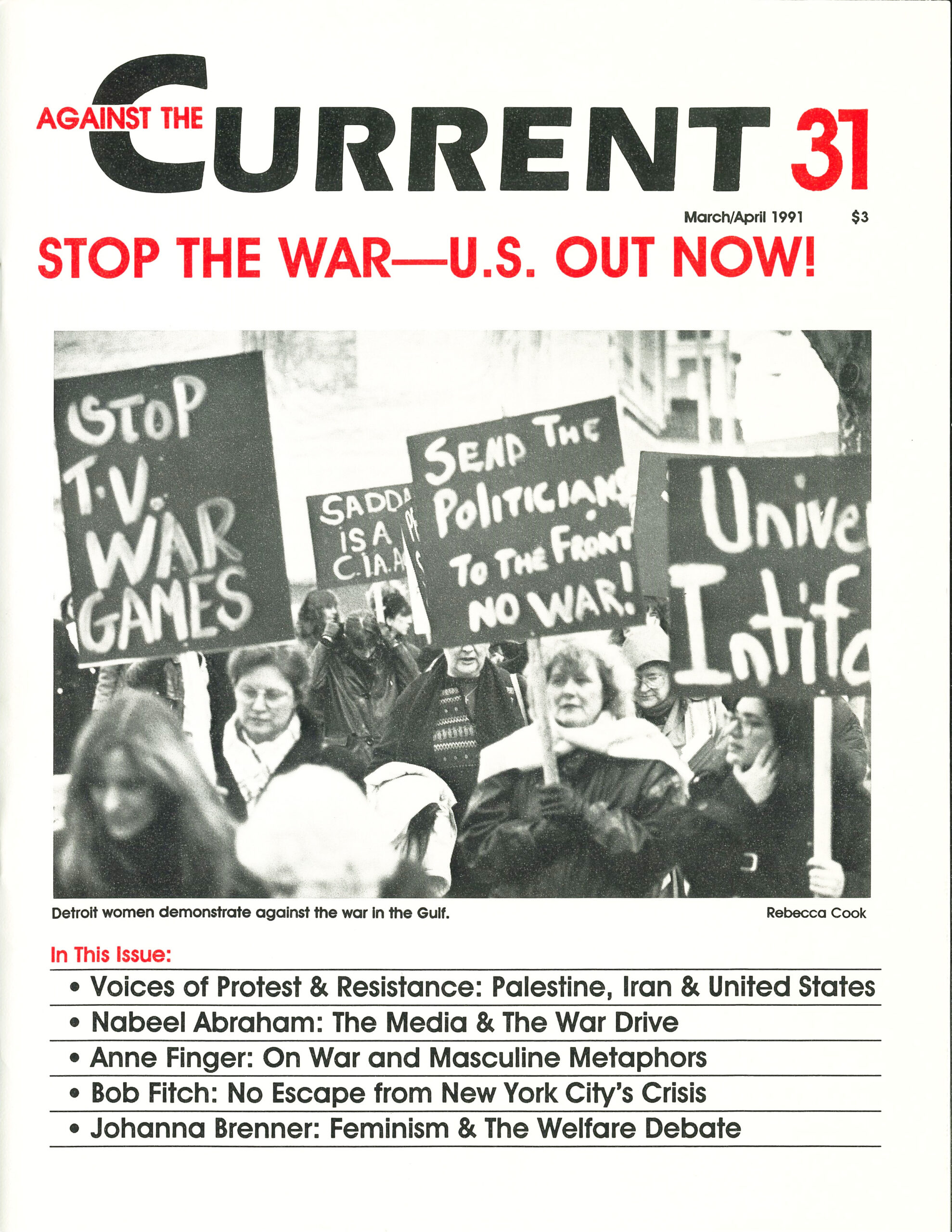Against the Current, No. 31, March/April 1991
-
Bring the Troops Home Now!
— The Editors -
What a Friend We Have in Dinkins
— Bob Fitch - International Women's Day--1991
-
The Rebel Girl: The Rapping Rebel
— Catherine Sameh -
Toward a Socialist-Feminist Strategy
— Johanna Brenner -
Women's Blood at the Root
— Mechthild Nagel -
Toward a New Imperium?
— interview with Janice Terry -
Palestine's Difficult Prospects
— interview with Anan Ameri -
Gulf War: An Iranian Perspective
— interview with Ali Javadi -
A Community Under Siege
— interview with Jessica Daher - The Intifada and Women's Struggle
-
Chemical War Against Civilians
— Israel Shahak -
Missiles, Masculinity and Metaphors
— Anne Finger -
The Media and the War Drive
— Nabeel Abraham -
Eco-Apocalypse Now
— Richard Latker -
A Hard Rain's Goin' to Fall
— John M. Miller -
Emergence of Iranian Workers
— Ali Javadi -
Citizenship and Civil Rights in Kuwait
— interview with Mahmood Ibrahim -
Tikkun and the Gulf War
— Justin Schwartz -
The Soviet Union and Iraq
— Hillel Ticktin -
Iraq: The Republic of Fear
— Joseph A. Massad -
Soviet Union-Eastern Europe, Part II: Nature of the Transition
— Robert Brenner -
Sexist and Misguided
— Sabiyha Robin Graham -
Another Commy Plot?
— John Vandermeer -
Random Shots: The Gulf War Miseries
— R.F. Kampfer
John M. Miller
ON JANUARY 21, the Pentagon reported that several oil wells were on fire in the Al Wafrah oil fields in Kuwait. A Kuwaiti oil refinery was also burning, apparently blown up or sabotaged by the Iraqis in an attempt to inhibit allied bombing raids. The bombing has continued, but a sooty “black rain” was reported falling on Bushehr province in Iran.
The Iraqis have said they have mined at least a third of Kuwait’s oil wells and the United States has been bombing much, if not all, of Iraq’s oil infrastructure. There are only four or five crews in the world experienced in putting out oil well fires. One well fire, under ideal conditions, can take weeks to extinguish, and experts estimate that it would take at least a year to put out all the fires. In the meantime, two to nine million barrels of oil per day would burn.
“Oil fires and oil contamination are the most serious environmental hazards of a war in the Gulf,” warns a statement issued before the war by some of the world’s leading scientists. Smoke, soot and chemicals produced by the burning of oil wells and facilities could cause temporary regional or global cooling.
Dr. Paul Crutzen of Germany’s Max Planck Institute predicts that one hundred days of burning from several hundred oil wells could produce a cloud of smoke covering half the Northern Hemisphere, lasting months if not years disrupting agriculture.
Should the fires last long enough, agriculture in India would be affected by the cooling or by the disruption of the monsoons, a scenario confirmed by a report issued by the British Meteorological Office. “Downwind of Kuwait,” the report says, “the obscuration of sunlight might significantly reduce surface temperature locally. This in turn could locally reduce the rainfall over parts of SE Asia during the period of the summer monsoon.” The result could be mass starvation.
Severe air pollution in the form of sulfur and nitrous oxides would return to earth as an intense form of acid rain. Pyrotoxins, poisons made from the burning of plastics and petroleum products, would also be produced. Soot and nitrogen oxides, if they travel high enough, can destroy the ozone in the most catastrophic and worst case scenario. This equatorial ozone hole would be far more serious than the one over Antarctica Ozone depletion can cause increased cancers and cataracts from exposure to ultraviolet light.
A study done for the Pentagon, while admitting that the fires would be “a massive and unprecedented pollution event,’ argues that the smoke would not travel high enough to affect large areas of the Northern Hemisphere or cause a measurable temperature change. But, according to Carl Sagan, should the fires burn into the spring, solar radiation would loft the smoke high into the atmosphere, where it cannot be easily rained out and will darken an area of unknown proportions.
March-April 1991, ATC 31

